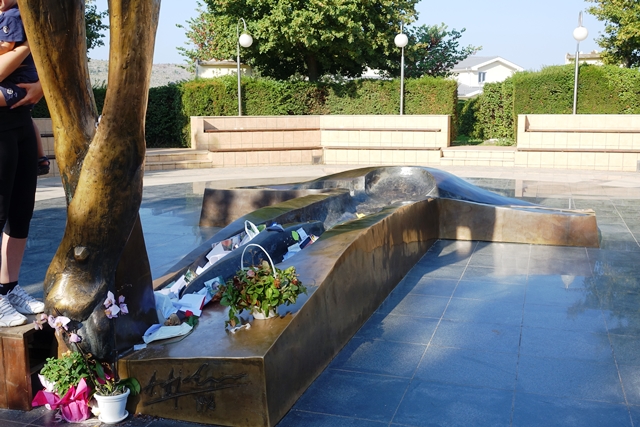While in
Medjugorje we attended Mass – usually twice daily – with occasional Adoration,
prayed the Rosary several times a day, visited some of the locations where the BVM is
said to have appeared (Blue Cross, Apparition Hill, Cross Mountain) and offered
personal prayers at these and other locations.
I did not experience
at any time anything in the least supernatural. There were no healings,
apparitions, voices, interior dialogues, supernatural flashes of light, disappearing
crosses, rosaries transformed from base metals into gold, dancing suns, strange
colours in the sky. Nothing.
On the other
hand I was privileged and humbled to see thousands of people openly demonstrate
their faith and love of God, sometimes walking barefoot, kneeling, hugging and
kissing the cross and the statues of Mary, singing and praying with emotion,
queuing for confession. None of this was new, what was different was the scale,
thousands of pilgrims united in witness and adoration, and the sense of God’s
presence, not just in the Host but also in a more general sense.
I have the
Grace of faith in the sense that I believe absolutely and completely in the
existence of God and fully affirm the Creed and the deposit of faith as taught
by the Church. However, if the Church declares that the apparitions of
Medjugorje are ‘worthy of belief’ they still do not belong to that deposit of
faith and personal belief in them is not mandatory. Although I have no doubt that the
visionaries are wonderful people and that many impressive fruits have their
origins in Medjugorje, the reservations of the Bishop of Mostar-Duvno and his
predecessor and colleagues continue to concern me and have not been overshadowed
by the wonderful experience of prayer and worship in Medjugorje.
Also, while
the Messages I have read and the ‘stones’ (daily prayer, fasting, bible reading,
monthly confession, Communion) are all highly commendable, I am baffled by the continuous
daily and monthly year-after-year transmission of similar requests, unheard of
in any other Marian apparition, and the apparent flexibility of dates concerning
signs and happenings.
Nevertheless,
as I mentioned earlier, I would recommend Medjugorje as a Holy Place, worthy of
pilgrimage. Concerning the apparitions and the origin of the messages, my strictly
personal view is that the old Scottish legal judgement of ‘not proven’ applies.
The Bosnia
and Herzegovina area, including its religious community, suffered greatly over the
last 70 years with the Second World War, imposition of the atheistic communist
state of Yugoslavia and the vicious Bosnian War of 1992-1995. Peaceful only for
the last 20 years, the shadow of recent war and martyrdom still lies over the
land. By all accounts the peasants were strong traditional Catholics with a
particular devotion to Our Lady and daily family prayers. The last 20 years
have also seen real GDP double but unemployment still hovers over 40%, and
corruption is widespread. However, Medjugorje has experienced a boom and the once-poor
village of farmers and stone houses has been transformed into a buzzing hive of
hotels, guest houses, souvenir shops and restaurants, attracting workers and
investors from nearby and as far away as Italy.
I was
interested in whether the local youth remain steadfast in the faith but it is
impossible to distinguish locals and visitors at the Masses – even when they
are in Croatian. The only sense I got was the comments by regular visitors that
when they visit in low season (October to March) the churches are packed with
locals and there are fewer non-Croatian Masses.
Nowadays - by
my calculations – Medjugorje, with about one million visitors annually, ranks sixth
on the global list of Christian shrines (after Guadalupe – 20M, Our Lady of
Aparecida in Brazil – 7M, Lourdes – 6M, Fatima 4-5M, Santiago de Compostela
1.5M). This is a phenomenal achievement after only 34 years. Type ‘Medjugorje’
into Google and there are 5.7 million hits...this sounds impressive but it should
be put into perspective; there are more than 100 million hits for each of
Guadalupe, Fatima and Lourdes, while Aparecida merits 52 million and Compostela
38 million. Yes, there seem to be many websites promoting Medjugorje and the
operation in Medjugorje itself is very well run and effective, but only time
will tell whether it has the stamina to be a top-ranking site for pilgrims.
By all
accounts Pope Francis is due to pronounce his view on Medjugorje sometime in
the coming months. While it is alleged that Saint Pope John Paul II was a
believer, the current Pope’s remarks about the messages have been interpreted
as dismissive. It would not surprise
me that he affirmed the status of Medjugorje as a Holy Place (echoing the 1991
Bishops Conference that described it as ‘a
holy place, a shrine’) but deferred any decision on the origin of the
messages – and perhaps even further restricted the ability of church
authorities to promote or offer facilities to the visionaries until a final
conclusion is reached.
But then I’ve
been wrong before! Why not visit and see
for yourself?



















































